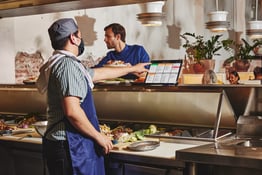So let’s say you’re an innovative restaurateur, running a popular establishment where business is booming almost beyond your capacity. Your staff can barely keep up with demand. Your servers have flat feet and your fry cooks have carpal tunnel, and you’re up to your ears in W2s. You identify a source of assistance for just a couple of grand a month: robots.
You research the latest in restaurant robotics and schedule consultations with the companies leading the way in automated food tech. In the end, you become the proud parent of a little Wall-E-ish server-bot, or maybe a mighty wall-mounted burger-flipping apparatus. Life with your restaurant robot looks sunny, at first. “Robots don’t take sick days,” you were promised on the initial call with the vendor. And yes, while it’s true they don’t ask for raises, the moment may come when something goes awry.
It turns out that robots do take sick days. Before you spring for one (or ten), you’d do well to ask yourself if you’re prepared for what it takes to nurse your new investment back to health. Because if you’re going to lead this new field of innovation, you’re bound to find yourself also on the front line of whatever snags and snarls come with it. Luckily there are some best practices that will help you ease into the future at your own pace.
What kinds of robots work in restaurants?
If you’re feeling like you’ve clicked your way into a bizarro universe — robotic restaurants?! what’s next, books on your phone? — don’t despair. Robotic tech solutions for restaurants and the rise of automation within the industry have been an evolving field of innovation for years now. More and more restaurant operators are turning to AI and robotics to automate repetitive tasks, both in the kitchen and front of house.
Some of these robots have become household names for the silicon set. Picture Flippy (a giant robotic arm that grills burgers at quick serve joints like White Castle), Servi (a cylindrical wheeled butler of sorts that serves food and busses tables), and Kiwibot (a compact and expressive delivery bot, capable of navigating a 1.5-mile radius on its own).
Restaurant operators appreciate robotic solutions for the value proposition. Though some have five-digit sticker prices, they make space in your labor budget, and, ultimately, work for nickels on the human dollar. They save your staff from the drudgery of dishwashing or burger flipping or tortilla chip frying or gathering dishes or monitoring the temperature of the coffee station. This leaves your human workers more time to interact meaningfully with customers. And they can be cool to watch in action, which attracts looky-loos-turned-diners and cements your reputation as a futuristic vanguard.
How do restaurant robots break?
Robot snafus tend to get attention because they’re so novel. You may have rubbernecked at some of the headlines of late, as when robot waiters in China were fired for their inability to keep food steady and their outright refusal of work (i.e., penchant to malfunction). Burger chain CaliBurger in 2018 saw its new Flippy go dark after a single day of work, due to errors in timing and difficulty coordinating tasks with human helpers. Far as we know, even the glitchiest restaurant robots have been better behaved than the Knightscope 5, a mall security bot that in 2016 toppled over a toddler.
When discussing robots, Ryne Simeone, Vendor Success Manager at Chicago-based 86 Repairs, cites Murphy’s Law. “With any piece of equipment, issues that cause breakdowns will arise. With robots, these units are typically modular construction,” he said, and he would know, as 86 Repairs specializes in end-to-end repair and maintenance services for multi-unit operators. "With robots, these units are typically modular construction. If the issue is hardware-related, a module may need replacement. Generally, you can divide your issues into two categories: software and hardware. Other malfunctions on the hardware side tend to be around cameras, sensors, calibration, and lubrication."
Most robots have mechanical joints that can get jammed up. Kitchen robots rely on cameras and heat sensors to ensure that food is cooked properly, and they’re calibrated to expect certain quantities of ingredients. Knock one component out of alignment and you're risking the quality of a dish, not to mention the safety of its ingredients.
So your robot conked out. Now what?
When your robot is ailing, the necessary course of action hinges on that software/hardware distinction. You may find yourself rooting for a software glitch, since the manufacturer can often diagnose the problem and fix it remotely, so long as your WiFi is still working. A hardware problem is going to require an on-site technician, usually from the company that made it. Trouble is, though, most of these manufacturers aren’t exactly General Motors. They’re often smallish startups with service teams clustered around their headquarters, making travel times daunting. “If your restaurant is across the country from the manufacturer, you’re looking at a technician having to fly in to help, which opens up a can of worms,” Simeone said.
What’s more, the technology is still so new that the number of qualified repairpeople at a given robotics company is limited. It doesn’t take too many repair requests to potentially overwhelm a manufacturer. In the future, as restaurants adopt ever more ‘bots, look for approved service provider programs and training programs for technicians that allows local repair firms to handle requests, in the way you’d have a local HVAC specialist fully capable of fixing your AC. “What a lot of these companies have in place right now is not necessarily proving to be the most scalable solution, to say the least,” Simeone said. “With third-party companies handling more of the repairs, the manufacturers could do what they’re best at — developing new tech, producing units, and getting them into restaurants.”
Do robots suffer problems that can be handled in-house — scrapes and bruises, if you will? Sure, anyone can try unplugging it and switching it back on. Before you get too much more advanced, you ought to be certain you know what you’re doing. Take for instance lubricating the robot. Totally doable, if you know you’re using the right materials in the right amounts. But if you use the wrong stuff, your robot’s joints will gum up, and potentially make matters worse.
How to keep your robot from breaking
Restaurant staff are fanatical about cleaning surfaces, dishes, and appliances. Add robots to the list. Your success in running a kitchen will depend on how fanatically you practice. preventative maintenance. Without regular cleaning, dust, grease, and food debris will accumulate on your robot’s cameras and sensors. When those get covered up, the robot will calibrate incorrectly, and your kitchen will go haywire. Likewise, you have to attend to the equipment the robot uses. Unlike the human worker who adapts on the fly, robots are poor at adjusting to crummy conditions. “For example, Flippy works with a fryer,” Simeone said. If the fryer isn’t maintained properly, guess what’s not going to work? If your fry baskets are dented or malformed, the robot isn’t going to hit its markers.”
In the immediate future, you’re going to want to keep your robots handling discrete, simple tasks, and taking the best of care of them as they do. Enlist a robot to do one thing well, and once you’ve figured out your workflow around that, consider adding one more robot, also to do one thing well. The world moves fast, but that doesn’t mean you have to. Heck, you and your customers probably don’t want to go full robo anyway. Just look at the closure of entirely automated concepts like Eatsa. People still appreciate a human touch, even when it was a robot arm that salted their waffle fries.





